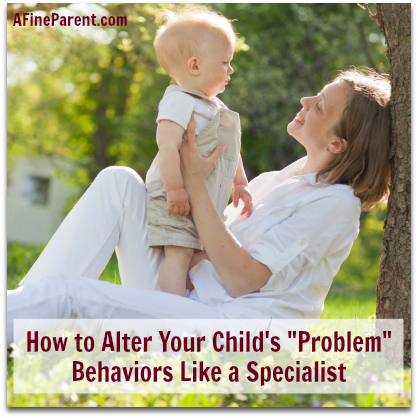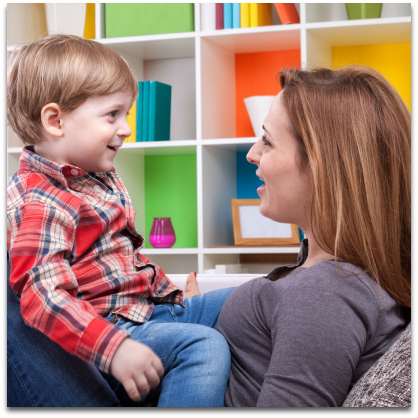 I walk into daycare at the end of the day.
I walk into daycare at the end of the day.
My 2 year-old is at the table, playing with Play-Doh.
Upon seeing me, he holds his little hand out in a “stop” motion. He shakes his head and says “no no no,” while covering the Play-Doh with his other chubby fingers.
His message is clear. Mom is here, so that means it’s time to go… but I’m having fun and I want to stay.
That’s okay because I’m in no rush. I hug my daughter and listen to her chatter about her day. I gather up jackets and backpacks while talking to our daycare provider.
At some point, my son gets down from the table, grabs his teddy bear, stands in the middle of the room, opens his mouth, and lets out an eardrum-blowing scream.
The kind of scream that rises to an octave so high, I’m pretty sure all the neighborhood dogs will have gathered outside.
Unprompted. Unexpected. Happy as a clam just a second ago.
Behaviors like this, especially when they happen often (this is not the first time I’ve heard that blood curdling scream come out of my cute little blonde-headed babe), can be frustrating.
The frustration is there because these behaviors often seem uncalled for. They are unpredictable and can be time-consuming. Whether it’s your toddler testing her new found sense of freedom, or an older child who is struggling with something more specific, it can be easy to get swept up in the frustration of the situation and start thinking of them as “problem” behaviors.
We may find ourselves reacting in ways that we are hoping will just stop the behavior on the spot. We may find ourselves yelling, reprimanding, threatening or picking our kids up and physically removing them from the situation.
Worse yet, we may find ourselves so frustrated by how the behavior has affected our day, that we don’t take the time to look deeper and understand why the behavior exists.
Here’s the rub: All behavior has a reason behind it.
I am a behavior specialist in a public school system in Maryland. I have 14 years of experience working with children from 3 to 21 in both the public and nonpublic school realms. I also have an almost unhealthy obsession for keeping up with the latest studies in this field; which comes in handy when it’s time to teach behavior-based trainings.
So I understand this: My 2 year-old screams for a reason.
Sometimes those reasons are easy to see. We work because the paycheck we get allows us to buy things we want and need. The little girl was laying on the floor and crying because her mom said no to the toy.
Sometimes the reasons are internal and not as easy to see. We work hard at our job because it makes us feel good when we are successful. The little boy keeps stomping his feet because the sensation of his feet touching the ground makes him feel good.
Why is this important?
 Understanding the function behind a child’s behavior allows us to plan for it and react to it in ways that will hopefully decrease it.
Understanding the function behind a child’s behavior allows us to plan for it and react to it in ways that will hopefully decrease it.
Research has shown that function-based interventions are more efficient and effective than interventions that are not matched to the function of behavior.
This function-based way of thinking about behavior is essential for working with children who have intense and frequent behavior challenges, as it allows us to develop interventions that will address the reasons behind the behavior.
However, this kind of mindset can also be helpful to parents dealing with the throes of a temper tantrum or a child who puts up a fuss every time you say “it’s time for homework.”
Here’s a cheat sheet I put together to help you look at the situation like a specialist the next time your child’s behavior completely baffles you and drives you up a bend.
First, Start by Answering These Simple Questions
Think about your child. Think about a particular behavior that you’ve observed. Think about a setting or situation that has resulted in behaviors on a frequent basis. Then ask yourselves these questions:
- When my child is performing the behavior, does he watch me to see if I am watching him?
- Would the behavior stop if I leave the room?
- Does the behavior often happen when my attention is on someone or something else?
- If I show my frustration by yelling, snapping or reacting in other ways, does the behavior increase?
- Does the behavior often happen when I ask my child to do something that is not a preferred?
- Does the behavior often happen when I ask my child to do something that is difficult for her?
- Would the behavior stop if I help him complete the task or no longer expect for it to be completed?
- Does the behavior happen often when my child does not get what she wants?
- Would the behavior happen if I took away a favorite toy, food or activity?
- If I gave my child a favorite toy or item, would the behavior stop?
- Does my child seem to enjoy the behavior?
- Does my child perform the behavior even if by himself?
- Does the behavior seem to occur when my child is around specific environmental stimuli?
If you answered yes to questions 1-4…
 … your child’s behavior may have an attention function.
… your child’s behavior may have an attention function.
Children crave attention; and it doesn’t always matter if it’s good or bad attention. In fact, children who learn that negative attention is easier to get than positive may become reinforced by seeing that they’ve succeeded in getting a rise out of you.
The key to handling attention based behaviors is two-fold: set up ways in which your child has access to positive attention for positive behaviors, and minimize negative attention for negative behaviors.
My daughter has an amazing habit of whining about everything that she needs, the second that she sees me on the phone… even if she was happily playing the minute prior.
If you believe that your child has an attention function, the following tips may be helpful:
- Remember to give lots of positive praise for positive behavior, even if it seems small.
- Set aside time every day to give your child your undivided attention. In the day and age with cell phones and social media, it’s easy to get distracted. Make a plan for when and how you are going set everything else aside and let your child know the plan- or even better, let them help make the plan!
- In the heat of chaos, be as nonreactive as possible. This is often referred to as planned ignoring, because you are making the decision beforehand to not react to the behavior. Take a deep breath. Keep and your facial expressions and body language neutral. Pretend like the behavior is no big deal, regardless of how you feel inside.
- Periodically remind your child of expectations with simple, calm words. “When you are quiet, then we can talk.”
If you answered yes to questions 5 through 7…
… your child’s behavior may have an escape function.
This means that your child is engaging in the behavior as an attempt to get out of something that he does not want to do. Much like hitting the “ignore” button on an unwelcomed phone call, your child is hoping that she can ignore the task, situation or activity by engaging in the behavior.
When asked to clean up the mess that he made, my son will often stand in the middle of the room, crying and whining until I either help him clean up or just do it for him.
If you believe your child’s behavior has an escape function, the following tips may be helpful:
- Prepare your child for what’s coming by letting them know in advance. Offer them access to something they enjoy after the less preferred activity is complete. Use simple language, such as “first we need to clean up and then we can read a book.”
- Make sure your child is able to do what you’re asking them to. It’s sometimes easy to assume that children have the skill set or stamina needed to complete what we are asking. If a certain skill isn’t developed enough yet, we may need to focus on teaching the skill before we can expect it. If a certain task is difficult for them, it may be helpful to break it into smaller steps so that it’s less overwhelming.
- Know when it’s okay to bail on the demand and when to follow through. The emotional and mental development of young children may sometimes mean that it’s best to allow them to escape and try again another time. Other situations may mean always coming back to the task, even if dealing with the behavior means putting it on hold for a short time.
If you answered yes to questions 8 through 10…
 … your child’s behavior may have an obtain function.
… your child’s behavior may have an obtain function.
You may think of this as the classic meltdown-in-the-store-when-she-can’t-have-the-toy that we’ve likely all dealt with at some point. However, this may also mean obtaining power or control of a situation; such as the child who doesn’t only want to do something but wants to do it HIS way. Our human race in general strives for control in our jobs, our finances, our physical health. It’s not a surprise that our children would too… especially since they always have adults telling them what to do!
My son will throw himself on the ground and cry every time it’s time to leave the park.
If you believe your child’s behavior has an obtain function, the following tips may be helpful:
- Give choices whenever you can. Presenting choices gives your child a sense of control, even if the choices you are offering are in your control.
- Give a countdown. Warn your child that time with a preferred item or activity is going to end. You can use the timer on your phone or one of these great items or apps to give your child a more concrete visual of time.
- Be patient. With the child who wants to get into the chair by himself. With the child who wants to wash herself in the bathtub. There will be times when we may have to “help”, simply because time is of the essence. However, these are signs that our children are exercising their independence and we should support them in that as much as possible, even if it means waiting.
- Set it up for them. Give your child the knowledge of when or how they will get access to that coveted toy or that favorite food. And then make sure you follow through when the time has come!
If you answered yes to questions 11 through 13…
… your child’s behavior may have an automatic function.
Automatic is really just another term for internal; much like the intrinsic motivation adults may have to engage in something because it makes us feel good… or avoid something that makes us feel bad. Automatic functions can be tricky because they aren’t observable in the same ways other functions are. We can never be certain that an environmental stimuli makes him feel anxious, or if a certain action or behavior makes him feel less anxious.
My daughter will stand, jump up and down and flap her arms whenever she is excited.
If you answered “no” to many of the first ten questions, then it’s important to think about the context in which your child shows the behavior; as well as the physical signs your child is demonstrating before, during and after the behavior. If you think your child’s behavior may have an automatic function, the following tips may be helpful:
- Pay careful attention to your child’s facial expressions and body language when they are engaging in the behavior. Behaviors that appear to relax or decrease anxiety may actually serve a positive purpose for the child. As long as the behaviors are not posing a risk to themselves or others, is there really a need to try to change or stop them?
- If particular sounds, smells, or environmental stimuli seem to produce the behaviors, be sure to prepare your child before walking into those situations. Think about ways you may be able to reduce those outside stimuli to make it more tolerable for your child.
- If the behavior is socially inappropriate, perhaps there is a more appropriate behavior that will serve the same purpose for the child. Think about alternatives and teach them during times in which your child is calm and in a comfortable environment.
Mixed Up Functions
 My answers don’t fall into one category. What does that mean?
My answers don’t fall into one category. What does that mean?
It’s not uncommon for problem behaviors to serve more than one purpose. This may be the case when a child has a common behavior that they exhibit in a variety of different conditions.
For example, a child who fusses at homework time may have the pretty obvious function of escape. But perhaps the same child’s fussing lasts twice as long with mom than it does with dad because mom typically gives a lot of attention and reacts to the behavior. In mom’s case, the behavior may hold both an escape and attention function. This is important for mom to know, because addressing the escape function alone may not result in any change in the behavior.
The 2-Minute Action Plan for Fine Parents
For our quick action plan, pick any behavior from one of your kids in the past 24 hours and walk through these steps:
- Answer the thirteen questions above.
- What function may be behind your child’s behavior?
- How can you incorporate the tips for that function into you and your child’s day?
- How can you change how you react to a behavior to better serve the function?
I would suggest picking at least one way in which you can change how you approach your child’s behavior and making the commitment to be consistent. Write it down for yourself, or even write it up for your child. Make it visual and easy to see, as a reminder of the commitment you made.
The Long-Term Action Plan for Fine Parents
For the rest of the week, follow through with your new approach to behavior. Remember that consistency is key to behavioral changes. You can’t expect to change your approach one time and to see a long-term difference.
Keep track of how your child reacts to your changes. Did you decide to give your child a better visual countdown to the end of playtime? Did you notice a decrease in the behavior when it was time to stop- or even a complete absence of the behavior? Write down the changes that you observe. Keep a log or just type them up in the notes app on your phone.
At the end of the week, look back over your notes and think about the progress that was made. If you have not seen progress, then ask yourself these questions:
- Do I still believe that the initial functions I identified are accurate; or would it be beneficial to re-evaluate the function and try a different approach?
- Is the lack of progress simply because I was not consistent or I need to be consistent for a longer period of time? Keep in mind that it is not unusual for behaviors to get worse before they get better, as children may try “other tricks” when what used to work is no longer working. Stick with it!
Thank you for pointing out that the human race desires control! I cringe when I get called in as a child counselor to help a child “learn that he doesn’t get to be in control!” It’s quite surprising how difficult it is for adults to recognize that just as they hate being micromanaged by a boss, so too do their children hate being micromanaged by their “boss.” I love any resource for parents that helps remind them that kids need a certain level of control in their lives, just as they do. Thanks for being one of those resources!
Thank YOU, Emily, for your tireless work to understand our little humans! I’m thankful that I was given this opportunity and platform to be a resource… Please share with anyone whom may benefit!
This is great!! I’d love to see a cheat sheet or check list to print out and pin up somewhere – a visual reminder we can quick run through in tough situations!
What a great idea, Shannon! I’ll see what I can do about that!